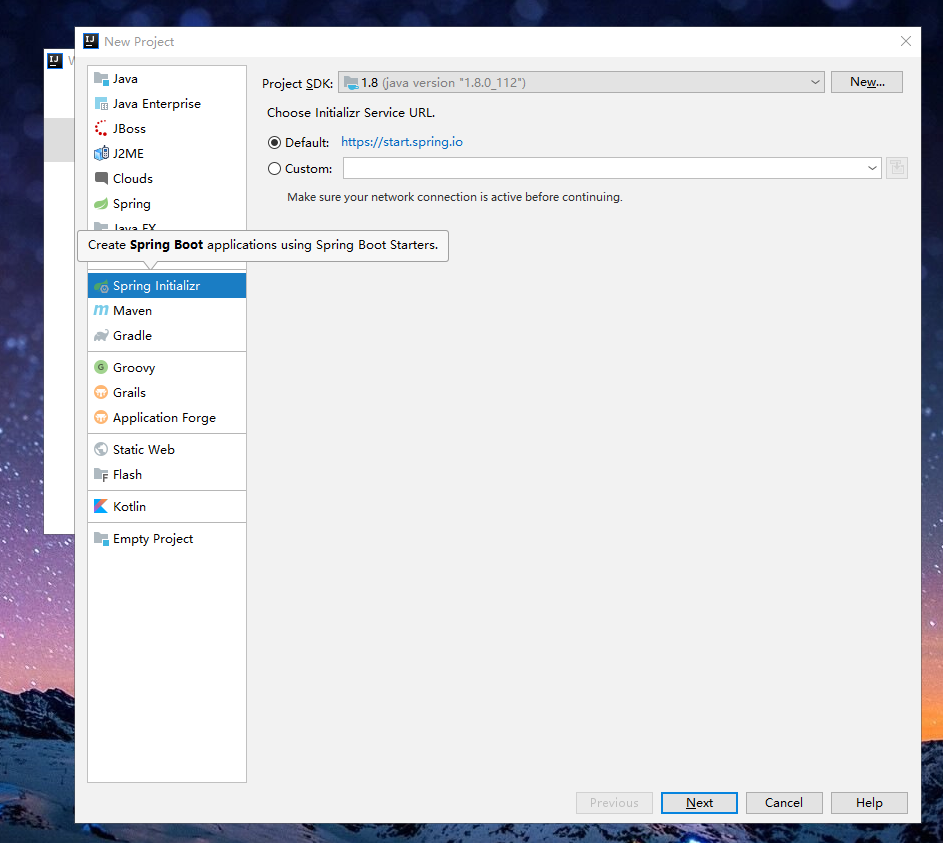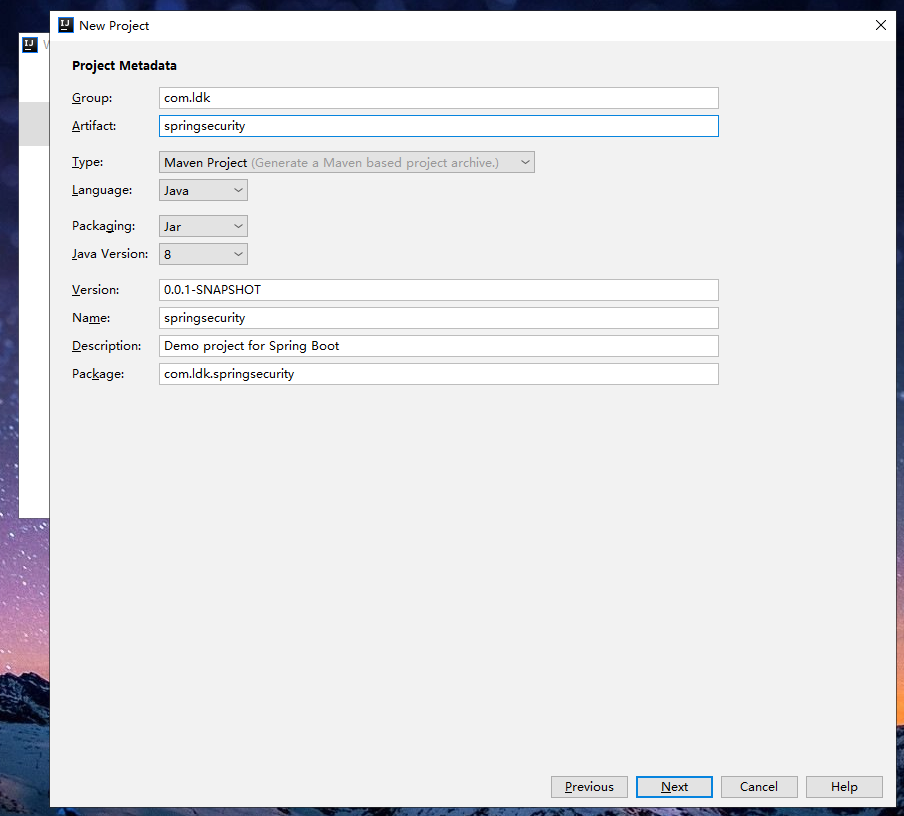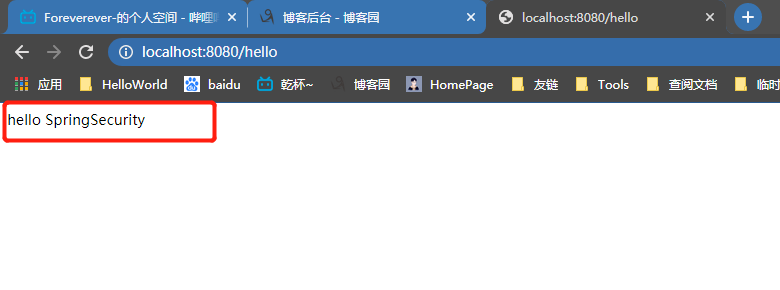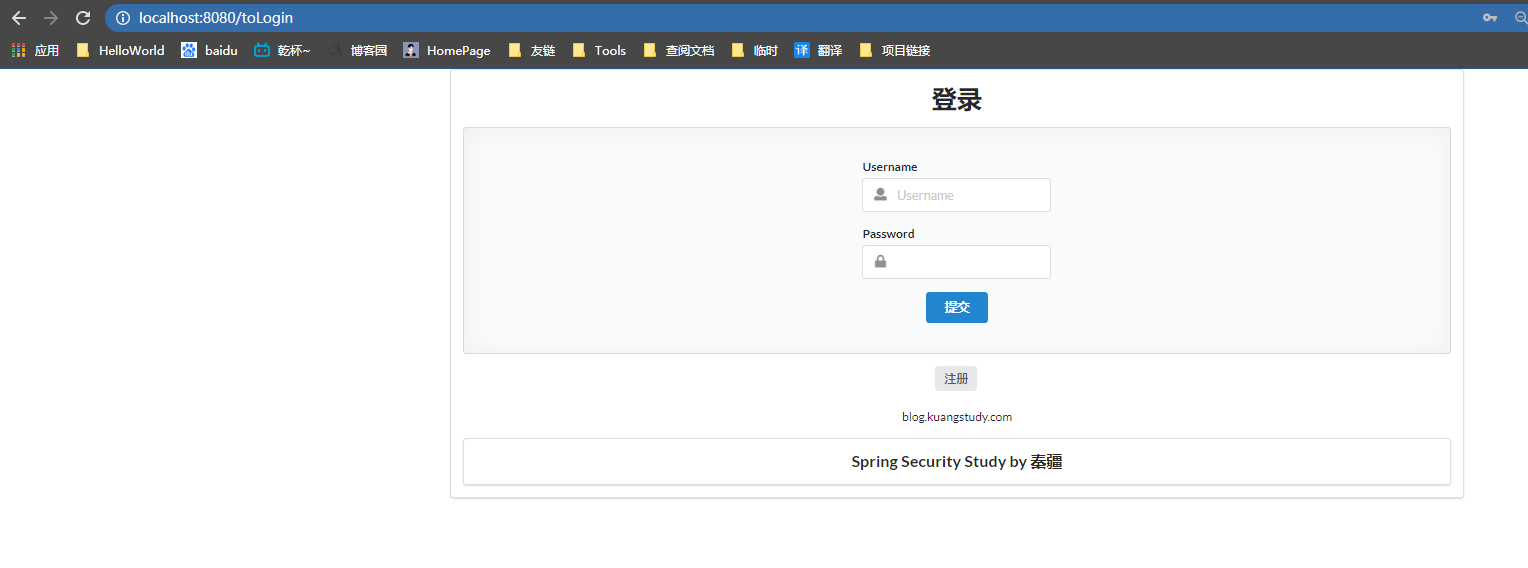SpringSecurity官网介绍:
1 Spring Security是一个功能强大且高度可定制的身份验证和访问控制框架。它是用于保护基于Spring的应用程序的实际标准。
2
3 Spring Security是一个框架,致力于为Java应用程序提供身份验证和授权。与所有Spring项目一样,Spring Security的真正强大之处在于可以轻松扩展以满足自定义要求
看了上面的介绍,可以知道SpringSecurity的主要功能就是:身份验证 和 权限控制
下面带大家进一步了解SpringSecurity的使用以及实现的过程
1、构建初始SpringBoot项目
1.1创建空项目
1.1.1选择SpringBoot项目

1.1.2项目命名

自动配置我们只选择Spring Web,其余的依赖自己来,为了方便控制

导入依赖
1 <!--thymeleaf整合security--> 2 <dependency> 3 <groupId>org.thymeleaf.extras</groupId> 4 <artifactId>thymeleaf-extras-springsecurity4</artifactId> 5 <version>3.0.4.RELEASE</version> 6 </dependency> 7 <!--security --> 8 <dependency> 9 <groupId>org.springframework.boot</groupId> 10 <artifactId>spring-boot-starter-security</artifactId> 11 </dependency> 12 <!--thymeleaf--> 13 <dependency> 14 <groupId>org.thymeleaf</groupId> 15 <artifactId>thymeleaf-spring5</artifactId> 16 </dependency> 17 <dependency> 18 <groupId>org.thymeleaf.extras</groupId> 19 <artifactId>thymeleaf-extras-java8time</artifactId> 20 </dependency> 21 <!--以下为系统系统自动导入,无需再次导入--> 22 <dependency> 23 <groupId>org.springframework.boot</groupId> 24 <artifactId>spring-boot-starter-web</artifactId> 25 </dependency>
好啦,现在总算把一个空项目新建完成了,接下来导入静态资源,这里我们提供一个网盘链接:
https://pan.baidu.com/s/1GlTmHAf2mmOuZc53Uf6jTQ
提取码:ypxc
大家可以自取,都是一些简单的页面和项目所需的css,js
新建一个Controller自测一下:
1 package com.ldk.controller; 2 3 import org.springframework.stereotype.Controller; 4 import org.springframework.web.bind.annotation.RequestMapping; 5 import org.springframework.web.bind.annotation.ResponseBody; 6 7 /** 8 * @Author: ldk 9 * @Date: 2020/5/19 21:44 10 * @Describe: 11 */ 12 @Controller 13 public class testController { 14 15 @RequestMapping("/hello") 16 @ResponseBody 17 public String hello(){ 18 return "hello SpringSecurity"; 19 } 20 }
项目总体结构如图:

启动项目,访问:http://localhost:8080/hello,又看到熟悉的:

这证明这个简单的Web项目可以跑通。
3、新建路由Controller
1 package com.ldk.Controller; 2 3 import org.springframework.stereotype.Controller; 4 import org.springframework.web.bind.annotation.PathVariable; 5 import org.springframework.web.bind.annotation.RequestMapping; 6 7 /** 8 * @Author: ldk 9 * @Date: 2020/5/19 12:55 10 * @Describe: 11 */ 12 @Controller 13 public class RouterController { 14 15 @RequestMapping({"/","/index"}) 16 public String index21(){ 17 return "index"; 18 } 19 @RequestMapping("/toLogin") 20 public String ind1ex(){ 21 return "views/login"; 22 } 23 24 @RequestMapping("/level1/{id}") 25 public String ind1ex1(@PathVariable("id")int id){ 26 return "views/level1/"+id; 27 } 28 @RequestMapping("/level2/{id}") 29 public String ind1ex2(@PathVariable("id")int id){ 30 return "views/level2/"+id; 31 } 32 @RequestMapping("/level3/{id}") 33 public String ind1ex3(@PathVariable("id")int id){ 34 return "views/level3/"+id; 35 } 36 37 }
4、上主菜(配置SecurityConfig)
我们都知道,无论SpringBoot或者SpringCloud与其他框架集成,都必须先导包,在创建Config类进行配置,然后加一个类似于@Enablexxx的注解,即可使用,SpringBoot集成SpringSecurity也不例外,这一步我们先创建一个空的SecurityConfig类 并集成 WebSecurityConfigurerAdapter 类,并重写他里面的两个方法,这里我们解释一下:WebSecurityConfigurerAdapter 类是个适配器, 在配置的时候,需要我们自己写个配置类去继承他,然后编写自己所特殊需要的配置,我们重写一下它的 认证 和 授权 方法,来实现自己的定制化个性服务。
在SpringSecurityApplication同级目录下新建config文件夹,并新建SecurityConfig配置类:
1 package com.ldk.config; 2 3 import org.springframework.security.config.annotation.authentication.builders.AuthenticationManagerBuilder; 4 import org.springframework.security.config.annotation.web.builders.HttpSecurity; 5 import org.springframework.security.config.annotation.web.configuration.EnableWebSecurity; 6 import org.springframework.security.config.annotation.web.configuration.WebSecurityConfigurerAdapter; 7 8 /** 9 * @Author: ldk 10 * @Date: 2020/5/19 13:38 11 * @Describe: 12 */ 13 14 @EnableWebSecurity 15 public class SecurityConfig extends WebSecurityConfigurerAdapter { 16 17 //授权 18 @Override 19 protected void configure(HttpSecurity http) throws Exception { 20 } 21 22 //认证 23 @Override 24 protected void configure(AuthenticationManagerBuilder auth) throws Exception { 25 } 26 27 }
。现在访问以下http://localhost:8080/ 顺利跳转首页,这个时候,首页的level1,level2,level3页面均可以有权限访问
下面我们通过操作SecurityConfig配置类,来做一些定制化需求实现
1、首页我都允许访问,但是level1、level2、level3页面均需要获取对应的vip1,vip2,vip3权限后才可以访问,没有权限跳转定制的登录页面
在授权方法加入授权规则:
//授权 @Override protected void configure(HttpSecurity http) throws Exception { //首页所有人可以访问,但是里面的功能页,只有对应有权限的人才能访问 //链式编程 //请求授权的规则 http.authorizeRequests().antMatchers("/").permitAll(). antMatchers("/level1/**").hasRole("vip1"). antMatchers("/level2/**").hasRole("vip2"). antMatchers("/level3/**").hasRole("vip3"); //没有权限 跳转登录页,需要开启登录页面 //定制登录页 http.formLogin().loginPage("/toLogin"); //这里我们也可以只写http.formLogin();这样他就会跳转到/login,这个页面时SprignSecurity为我们准备好的登录页面 }
现在重启项目,发现只有首页能访问,其他页面都会自动跳转到我们自己编写的登录页面:

我们只是做了一些简单的配置工作,SpringSecurity在底层已经为我们做好了一切,框架就是这样,拿来就用,如果自己想明白原理,可以点进去源码研究一下。
接下来我们要实现指定用户能访问某些页面,就要修改身份认证的配置方法,这里的用户名密码需要从数据库查询,我们就用几组死数据代表了:
//认证 //密码编码 passwordEncoder //在SpringSecurity 5.x中 新增了很多加密方法 @Override protected void configure(AuthenticationManagerBuilder auth) throws Exception { //正常这些数据应该从数据库读取 auth.inMemoryAuthentication().passwordEncoder(new BCryptPasswordEncoder()) .withUser("kuangshen").password(new BCryptPasswordEncoder().encode("123456")).roles("vip2","vip3") .and().withUser("root").password(new BCryptPasswordEncoder().encode("123456")).roles("vip1","vip2","vip3") .and() .withUser("guest").password(new BCryptPasswordEncoder().encode("123456")).roles("vip1"); }
需要注意的是我们在密码外面包裹了一层 BCryptPasswordEncoder.encod方法,这是SprignSecurity的一个密码校验,现在重启项目,在登录页面输入我们设定的账号密码,神奇的发现,页面确实进行了授权。
注销及权限控制:
想实现注销按钮,首先在首页添加一个注销按钮:
修改授权配置类,开启注销功能:
//授权 @Override protected void configure(HttpSecurity http) throws Exception { //首页所有人可以访问,但是里面的功能页,只有对应有权限的人才能访问 //链式编程 //请求授权的规则 http.authorizeRequests().antMatchers("/").permitAll(). antMatchers("/level1/**").hasRole("vip1"). antMatchers("/level2/**").hasRole("vip2"). antMatchers("/level3/**").hasRole("vip3"); //没有权限 跳转登录页,需要开启登录页面 //定制登录页 // http.formLogin().loginPage("/toLogin"); http.formLogin(); //这里我们也可以只写http.formLogin();这样他就会跳转到/login,这个页面时SprignSecurity为我们准备好的登录页面 //开启注销功能 //防止网站攻击 csrf 防止 // 跨站攻击(代码是配置死的) http.csrf().disable(); http.logout().logoutSuccessUrl("/"); }
下面进行权限的控制,我们想让用户登录成功之后只可以看到自己可以看到的页面,自己没有权限的页面看不到,这个需要在前端index页面做手脚即可,我们一开始已经集成了 thymeleaf整合security 的包,直接判断用户是否登陆,就可以校验出用户是否有权限。
<!DOCTYPE html>
<html lang="en" xmlns:th="http://www.thymeleaf.org"
xmlns:sec="http://www.thymeleaf.org/thymeleaf-extras-springsecurity4">
<head>
<meta charset="UTF-8">
<meta name="viewport" content="width=device-width, initial-scale=1, maximum-scale=1">
<title>首页</title>
<!--semantic-ui-->
<link href="https://cdn.bootcss.com/semantic-ui/2.4.1/semantic.min.css" rel="stylesheet">
<link th:href="@{/qinjiang/css/qinstyle.css}" rel="stylesheet">
</head>
<body>
<!--主容器-->
<div class="ui container">
<div class="ui segment" id="index-header-nav" th:fragment="nav-menu">
<div class="ui secondary menu">
<a class="item" th:href="@{/index}">首页</a>
<!--登录注销-->
<div class="right menu">
<!--未登录 显示登录按钮-->
<div sec:authorize="!isAuthenticated()">
<a class="item" th:href="@{/toLogin}">
<i class="address card icon"></i> 登录
</a>
</div>
<!--已登录 显示注销按钮 和用户名-->
<div sec:authorize="isAuthenticated()">
<a class="item">
用户名:<span sec:authentication="name"></span>
</a>
</div>
<div sec:authorize="isAuthenticated()">
<a class="item" th:href="@{/logout}">
<i class="sign-out card icon"></i> 注销
</a>
</div>
<!--已登录
<a th:href="@{/usr/toUserCenter}">
<i class="address card icon"></i> admin
</a>
-->
</div>
</div>
</div>
<div class="ui segment" style="text-align: center">
<h3>Spring Security Study by DK</h3>
</div>
<div>
<br>
<div class="ui three column stackable grid">
<!--菜单根据用户角色进行显示-->
<div class="column" sec:authorize="hasRole('vip1')">
<div class="ui raised segment">
<div class="ui">
<div class="content">
<h5 class="content">Level 1</h5>
<hr>
<div><a th:href="@{/level1/1}"><i class="bullhorn icon"></i> Level-1-1</a></div>
<div><a th:href="@{/level1/2}"><i class="bullhorn icon"></i> Level-1-2</a></div>
<div><a th:href="@{/level1/3}"><i class="bullhorn icon"></i> Level-1-3</a></div>
</div>
</div>
</div>
</div>
</div>
<div class="column" sec:authorize="hasRole('vip2')">
<div class="ui raised segment">
<div class="ui">
<div class="content">
<h5 class="content">Level 2</h5>
<hr>
<div><a th:href="@{/level2/1}"><i class="bullhorn icon"></i> Level-2-1</a></div>
<div><a th:href="@{/level2/2}"><i class="bullhorn icon"></i> Level-2-2</a></div>
<div><a th:href="@{/level2/3}"><i class="bullhorn icon"></i> Level-2-3</a></div>
</div>
</div>
</div>
</div>
<div class="column" sec:authorize="hasRole('vip3')">
<div class="ui raised segment">
<div class="ui">
<div class="content">
<h5 class="content">Level 3</h5>
<hr>
<div><a th:href="@{/level3/1}"><i class="bullhorn icon"></i> Level-3-1</a></div>
<div><a th:href="@{/level3/2}"><i class="bullhorn icon"></i> Level-3-2</a></div>
<div><a th:href="@{/level3/3}"><i class="bullhorn icon"></i> Level-3-3</a></div>
</div>
</div>
</div>
</div>
</div>
</div>
</div>
<script th:src="@{/qinjiang/js/jquery-3.1.1.min.js}"></script>
<script th:src="@{/qinjiang/js/semantic.min.js}"></script>
</body>
</html>
主要是添加了 thymeleaf的空间域名,写代码的时候 会有提示,并且保证语法不报错
现在访问页面,发现首页的菜单已经很好的被控制住了,只能显示经过我们授权后的菜单链接。
以上代码均来自于狂神,bilibili链接:https://space.bilibili.com/95256449,大家可以去网站找到对应的教学视频。再一次感谢狂神。